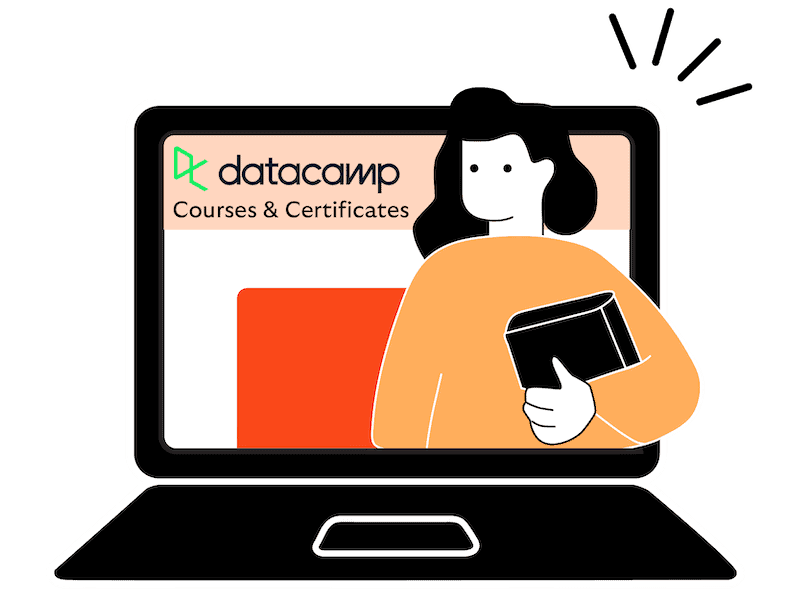Navigating the world of DataCamp can feel a bit overwhelming, especially with so many tracks, courses, and resources to choose from. If you’re looking to gain in-demand data skills, prepare for a flexible job, or even change careers, DataCamp is a great starting point. Let’s dive into my top six tips for choosing the perfect DataCamp course for your goals!
That’s why I’ve put together my top 6 tips for choosing the perfect DataCamp course. These tips have been incredibly helpful for me when selecting the right track or course. So, when you’re ready to start learning with DataCamp, keep these tips in mind. I hope they guide you to the best choice and help you achieve your goals!
Catherine CookeUpskillwise Advisor
My Honest Experience With DataCamp
Visit DataCamp1. Pick Your Path
If you’re not sure where to begin, start by exploring DataCamp’s Skill and Career Tracks. Think of them as guided roadmaps designed to help you master top skills for specific roles.
Skill Tracks: These typically consist of 3-7 courses, focusing on specific skills in programming languages like Python, R, and SQL. They are suitable for learners at various levels, including beginners.
Career Tracks: These are more comprehensive, ranging from 12 to 30 courses. They start with introductory courses and progress to advanced topics, preparing you for specific roles such as Data Analyst or Data Scientist.
Whether you’re aiming to become a data analyst or transition into another tech role, these tracks provide structured learning paths to help you succeed.

2. Boost Your Credentials
One of the great things about DataCamp is that you’ll receive a Statement of Accomplishment upon completing a track. While it’s not an accredited certification, it’s a valuable way to showcase your new skills on LinkedIn or your resume.
For those exploring DataCamp alternatives, you might find platforms like Coursera or Udacity offering university-backed certifications. However, if you’re focused on practical, hands-on learning, DataCamp is a solid choice to demonstrate your expertise and stand out in the job market.

3. Dive in for Free
Not ready to commit to a paid plan? You’re in luck—DataCamp allows you to access the first chapter of most courses for free. This is an excellent way to explore topics, assess the platform’s teaching style, and decide whether DataCamp’s pricing plans align with your budget.
Pro tip: Try a free chapter from a Data Analyst Career Track to see if the content resonates with your learning style.

4. Learn from Pros
One unique feature of DataCamp is its instructor profiles, where you can learn about the educators behind the courses. Many instructors are DataCamp staff experts, while others hail from prestigious universities like Oregon State or Washington State.
That said, if you’re someone who values in-depth instructor bios or social media links, you might find online learning platforms like Coursera or MasterClass more robust in this department. Still, the concise profiles on DataCamp are more than enough to inspire confidence in the quality of teaching.

5. Find Your Level
If you’re feeling stuck or unsure where to begin, take advantage of DataCamp’s free skills assessments. These quick, 5-10 minute tests evaluate your knowledge in areas like Python, R, or SQL.
- Complete the assessment (no credit card needed!).
- Review your results, which are mapped to skill levels: Novice, Intermediate, or Advanced.
- Get personalized course recommendations tailored to your current abilities.
- It’s a great way to discover your strengths, pinpoint gaps, and find the perfect starting point.
6. Find Your Data Tribe
Learning is always more fun with a supportive community, and DataCamp doesn’t disappoint. Their vibrant community hub features tutorials, cheat sheets, resource centers, and even a podcast to keep you motivated.
For real-time engagement, check out their Slack channels. Whether you’re asking for feedback, exploring flexible jobs, or just connecting with like-minded learners, the community can be an invaluable resource.

Final Thoughts
Choosing the right course on DataCamp doesn’t have to be daunting. By exploring Skill and Career Tracks, starting with free resources, and leveraging features like assessments and community support, you’ll be well on your way to mastering top skills.
If you’re still weighing your options, don’t forget to consider DataCamp alternatives to see how it compares. But if you’re ready to dive into data skills and AI, DataCamp offers one of the most accessible and hands-on learning experiences out there.
So, whether you’re aiming for a career shift, leveling up in your current role, or just exploring your interest in data, there’s no better time to start. Good luck, and happy learning!




